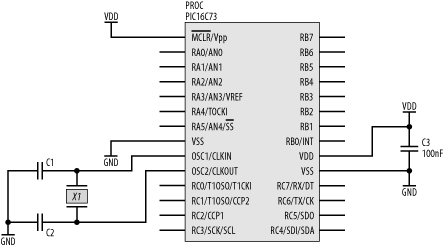In this section, we’ll look at the PIC16C73 processor. For a midrange PIC, the design is not dissimilar to the simpler PIC we’ve already looked at. The only real difference is that the processor has more pins, more I/O, and more functionality. We’ll look at what you can do with its various I/O subsystems in Part III of this book.
The address space for this processor is shown in Figure 5-6.
The schematic for this processor is shown in Figure 5-7. This processor has 4K words of program memory, 192 bytes of RAM, and a variety of I/O subsystems, such as three timer modules, SPI, I2C, a UART, five channels of analog input, and up to 22 digital I/O pins.
This processor has one power pin (VDD) and two ground pins (VSS). As always, power is decoupled to ground with a small capacitor (C3). The only other requirements are some form of clock generation, in this case provided by a crystal, X1, and two decoupling capacitors, C1 and C2. The clock could just as easily have been provided using an RC circuit, as we saw with the 12C508. The reset input, MCLR , is tied directly to the power supply, so that is permanently inactive. In this case, we are relying on the processor’s internal power-on reset circuitry and don’t need to provide an external reset. It is common practice to use a pull-up resistor to tie an unused input, such as MCLR , inactive. However, in this case, I have found that a pull-up resistor can affect the activation of the internal power-on reset to the point that it fails to kick in. Thus, the resistor can actually cause the processor to never start properly. So, in this case, it’s better to leave it out.
This basic design, in combination with the appropriate datasheet, can be adapted to most other PIC processors that you will come across.
In the next chapter, we’ll take a look at the AVR processor family. These processors are comparable to PICs in terms of I/O and functionality but have a higher throughput and a more versatile architecture.


